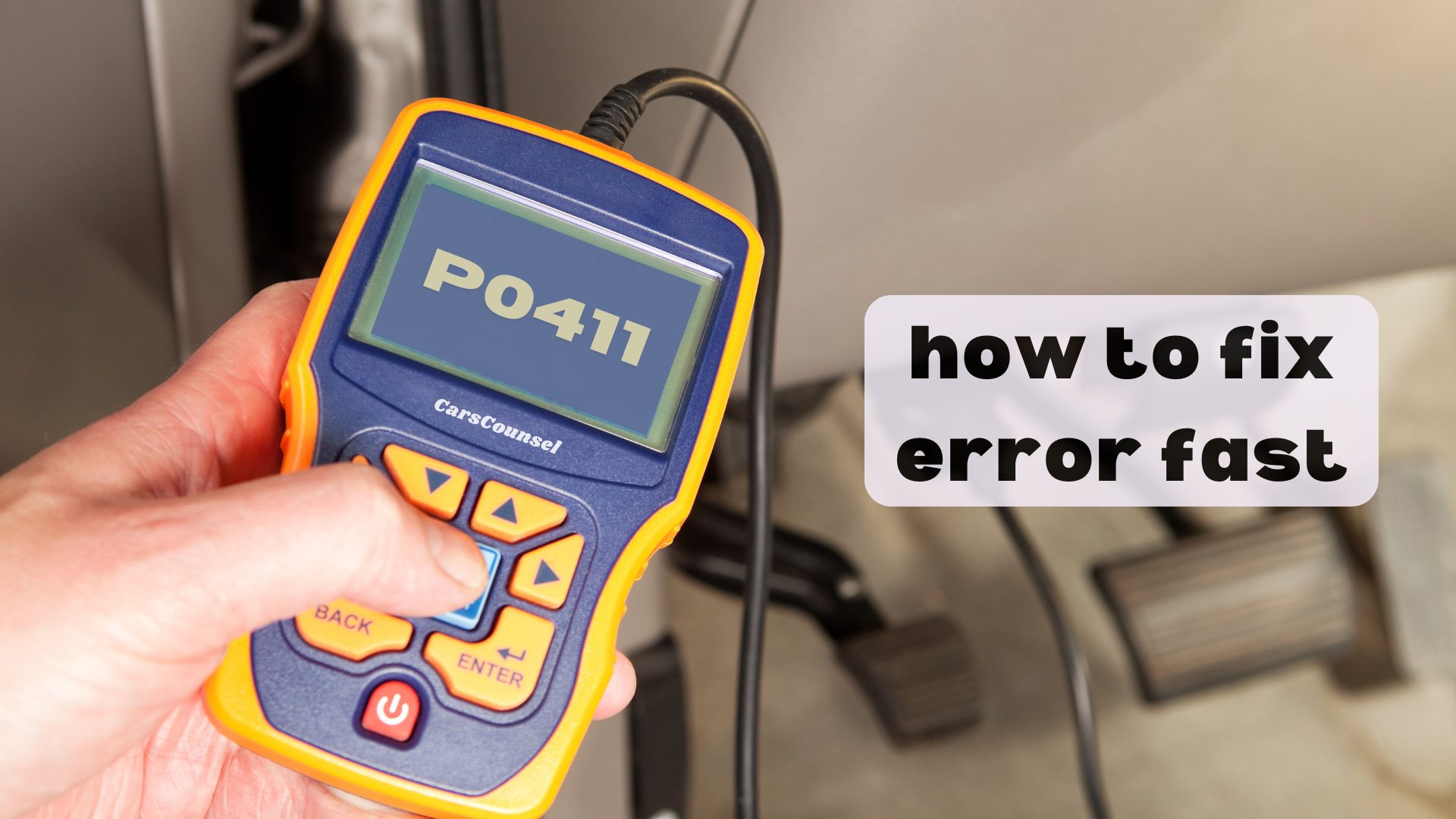As you turn the key, your engine roars to life, but beneath the surface, a silent assassin is lurking – a faulty Secondary Air Injection system. The P0411 code is like a red flag waving in the darkness, signaling that something is amiss. It’s a warning that your engine’s airflow is off-kilter, and if left unchecked, it could lead to decreased performance, poor fuel economy, and even air quality issues.
But what’s causing this airflow anomaly? Is it a faulty pump, a blockage, or something more sinister? The diagnosis is just the beginning, and the solution lies hidden in the complex web of your vehicle’s AIR system.

Quick Navigation
Key Takeaways
- The P0411 code indicates a fault in the Secondary Air Injection (AIR) system, which reduces emissions during cold engine operation.
- Incorrect airflow detection can be caused by faulty air pumps, blockages, air leaks, or pump failure, which can decrease engine performance and cause air quality issues.
- Diagnosing the P0411 code issue involves connecting a scan tool to the OBD-II system, interpreting the code, and inspecting AIR system components for damage or blockages.
- Replacing faulty AIR system parts, such as the air filter, pump, check valves, and hoses, with OEM-quality parts can resolve the issue.
- Clearing the DTC code and performing a test drive to verify that the AIR system is functioning correctly are crucial to ensuring successful repairs.
Code P0411 Description and Meaning
When your vehicle’s onboard computer triggers the P0411 code, it’s indicating a fault in the Secondary Air Injection (AIR) system.
This system is designed to reduce emissions during cold engine operation by introducing fresh air into the exhaust stream, helping the catalytic converter reach operating temperature more quickly.
The AIR system is a critical component of emission regulation, and a fault in this system can lead to increased emissions output.
A faulty air pump, a common cause of the P0411 code, can disrupt the flow of air in the secondary air injection system, triggering the trouble code.
It’s essential to address this issue promptly to avoid further damage to your vehicle’s emission control system.
Causes of Incorrect Airflow Detected
As you investigate the P0411 code, it’s vital to identify the root cause of the incorrect airflow detected in the AIR system.
You’ll need to perform a thorough analysis to determine why the system is malfunctioning. Common causes of incorrect airflow detection include a faulty AIR pump, which can disrupt airflow and trigger the code.
Blockages in the AIR system, such as debris or carbon buildup, can also restrict airflow and lead to incorrect flow detection. Air leak detection is essential to identify any leaks in the system that may be causing air to escape.
Additionally, pump failure analysis can help you determine if the AIR pump is functioning properly. By identifying the root cause, you can take the necessary steps to repair the AIR system and resolve the P0411 code.
Symptoms of a Faulty AIR System
Frequently, the first indication of a faulty AIR system is the illumination of the check engine light on your vehicle’s dashboard, accompanied by a stored trouble code, such as P0411.
As the AIR system malfunctions, you may experience a decrease in engine performance, including reduced power and acceleration.
The engine may idle rough or inconsistently, indicating a potential issue with the AIR system.
Additionally, you may notice air quality issues, such as increased emissions, which can lead to failed emissions tests.
These engine performance impacts can also result in poor fuel economy or difficulty starting the engine.
It’s essential to address the faulty AIR system promptly to avoid further damage and potential costly repairs.
Diagnosing the P0411 Code Issue
To diagnose the P0411 code issue, you’ll need to connect a scan tool to your vehicle’s onboard diagnostics (OBD-II) system to retrieve the specific trouble code and diagnose the exact cause of the incorrect airflow.
This will give you a better understanding of what’s happening within the Secondary Air Injection (AIR) system. You’ll need to interpret the code and determine if it’s related to a faulty AIR pump, blockages, leaks, or faulty check valves.
Air System Diagnosis is vital in identifying the root cause of the problem. Code Interpretation is key to understanding the specific issue and developing a plan to fix it.
Inspecting AIR System Components
Your visual inspection of the AIR system components is crucial in identifying potential issues that may be causing the P0411 code.
You’ll want to carefully examine each part to guarantee they’re functioning properly.
1. Air Filter: Check the air filter for any signs of damage, dirt, or clogging.
A dirty or clogged air filter can restrict airflow, leading to incorrect flow detected in the AIR system.
2. System Leaks: Inspect the AIR system hoses, connections, and valves for any signs of leaks.
Leaks can cause air to escape, affecting the system’s operation and triggering the P0411 code.
3. Electrical Connections: Verify that all electrical connections to the AIR system components are secure and free from corrosion.
Loose or corroded connections can disrupt the system’s operation, leading to incorrect flow detected.
Replacing Faulty AIR System Parts
When replacing faulty AIR system parts, you’ll need to identify the specific component causing the issue and procure a suitable replacement.
Inspect the AIR pump, check valves, and hoses for signs of damage or wear. If the AIR pump is faulty, you may need to perform Pump Maintenance to guarantee proper function.
Air Filter Replacement is also vital to maintain peak airflow. Replace any damaged or clogged components with OEM-quality parts to guarantee reliable operation.
Remember to consult your vehicle’s repair manual or a professional mechanic if you’re unsure about the replacement process. By replacing faulty AIR system parts, you’ll restore proper airflow and resolve the P0411 code.
Clearing DTC Codes and Testing
Once the faulty AIR system components have been replaced, it’s essential to clear the Diagnostic Trouble Code (DTC) from the Engine Control Module (ECM) to guarantee the check engine light is turned off and the vehicle’s onboard systems are reset.
To certify the issue is fully resolved, follow these steps:
- Clear the DTC code from the ECM using a scan tool to prevent the code from reappearing.
- Perform a test drive to verify that the AIR system is functioning correctly and the code isn’t triggered again.
- Implement test drive strategies, such as driving at varying speeds and engine loads, to simulate real-world driving conditions and confirm the AIR system is operating within specifications.
Emissions Testing and Verification
Emissions testing is a critical step in verifying that the repaired AIR system is operating within acceptable levels. You’ll want to guarantee the vehicle meets emissions standards, which vary by region and country. The verification process involves testing the vehicle’s emissions output to confirm the repairs have been successful.
| Emissions Standard | Verification Process |
|---|---|
| Federal Emissions Standard | OBD-II onboard diagnostics |
| California Emissions Standard | Smog check testing |
| European Emissions Standard | Euro 6 testing protocol |
| Japanese Emissions Standard | Japanese Ministry of Land, Infrastructure, Transport, and Tourism testing |
| Canadian Emissions Standard | On-board diagnostics and emissions testing |
Average Cost to Fix P0411 Code
Repairing a P0411 code can be a costly endeavor, and understanding the average cost to fix it’s vital in planning your budget.
You’ll want to get repair estimates from multiple shops to compare prices and find the best deal.
Some typical costs associated with fixing a P0411 code:
- Labor costs: Expect to pay between $75 and $150 per hour, depending on the shop’s labor rate.
- Parts costs: Replacement parts, such as the AIR pump or check valves, can range from $100 to $500.
- Diagnostic fees: Some shops may charge a diagnostic fee, which can range from $50 to $100, depending on the shop’s policies.
Factors Affecting Repair Costs
When estimating the cost to fix a P0411 code, several factors come into play, influencing the final repair bill.
You’ll need to weigh the labor rates at the auto repair shop, which can vary depending on the geographic location. For instance, labor rates tend to be higher at dealerships or in metropolitan areas, while independent shops may offer more competitive pricing.
Additionally, the complexity of the repair and the time required to diagnose the issue will also impact the final cost.
Moreover, the cost of replacement parts, such as the AIR pump or check valves, will also be factored into the overall repair bill.
Additional Resources and Tips
Beyond the repair guide, you’ll find it helpful to access additional resources to fix a P0411 code.
These resources can provide more in-depth information and guidance to guarantee you’re tackling the issue correctly.
- Factory service manuals: These manuals provide detailed information on the AIR system and its components, helping you diagnose and repair the issue more efficiently.
- Online repair guides: Websites like AllData and Autozone offer comprehensive repair guides, including diagrams and tutorials, to help you fix the P0411 code.
- DIY tutorials and forums: Websites like YouTube and online forums dedicated to your vehicle’s make and model can provide valuable insights and tips from experienced DIYers who’ve already fixed the issue, thereby guaranteeing a successful repair.
More OBD-II Codes
Frequently Asked Questions
Can a Faulty Oxygen Sensor Cause a P0411 Code to Appear?
You’re wondering if a faulty oxygen sensor can trigger a P0411 code; while it’s unlikely, a sensor malfunction can indirectly cause air flow issues, potentially leading to incorrect flow detection and the code, but it’s not a direct cause.
Will a P0411 Code Trigger a Smog Test Failure Automatically?
Like a puzzle missing a vital piece, a smog test failure isn’t automatically triggered by a P0411 code; however, you may be eligible for smog test exemptions or emissions waivers if you can prove the issue doesn’t significantly increase emissions.
Can I Drive My Vehicle With a P0411 Code Safely?
When driving with an incorrect air injection system flow, you can safely cover a limited mileage, but take driving precautions: monitor engine performance, avoid high speeds, and watch for signs of engine damage or overheating, as prolonged driving can exacerbate the issue.
Do All Vehicles Have a Secondary Air Injection System?
You’re not alone in wondering if all vehicles have a secondary air injection system! Not quite, as only certain vehicle types, typically those with stricter emission controls, are equipped with this system to reduce emissions during cold engine operation.
Will a Tune-Up Resolve a P0411 Code Issue?
You won’t resolve a P0411 code issue with a tune-up alone, as it addresses air flow issues in the secondary air injection system, which affects fuel efficiency concerns; a thorough diagnosis and repair of the faulty component is necessary.
Conclusion
As you wrap up the diagnosis and repair of the P0411 code, recollect that a faulty Secondary Air Injection system is like a ticking time bomb, waiting to release a toxic cocktail of emissions and performance issues. Don’t let it simmer in the background – tackle the problem head-on to avoid a costly and environmentally hazardous fallout. With the right tools and know-how, you can defuse the situation and get your engine running smoothly and efficiently once again.

